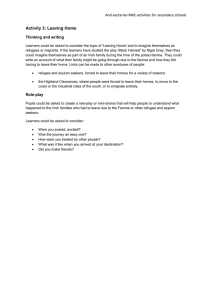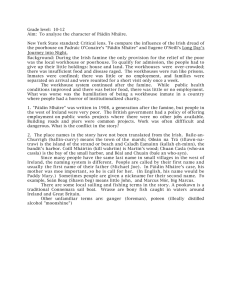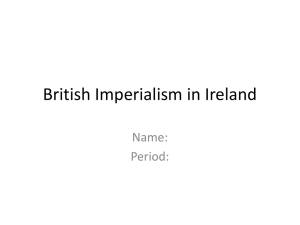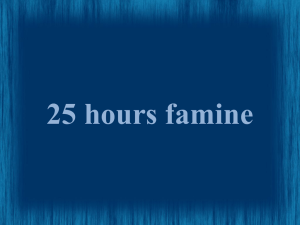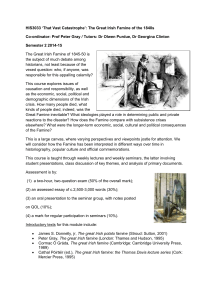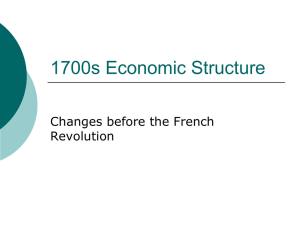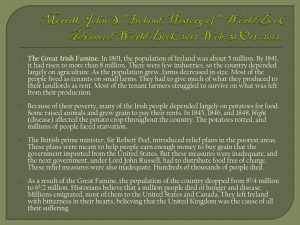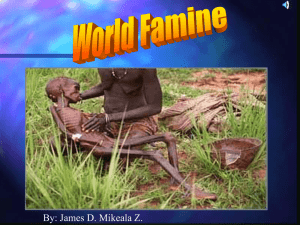INTERDISCIPLINARY MIDDLE GRADES (4-8) PACKAGE
advertisement
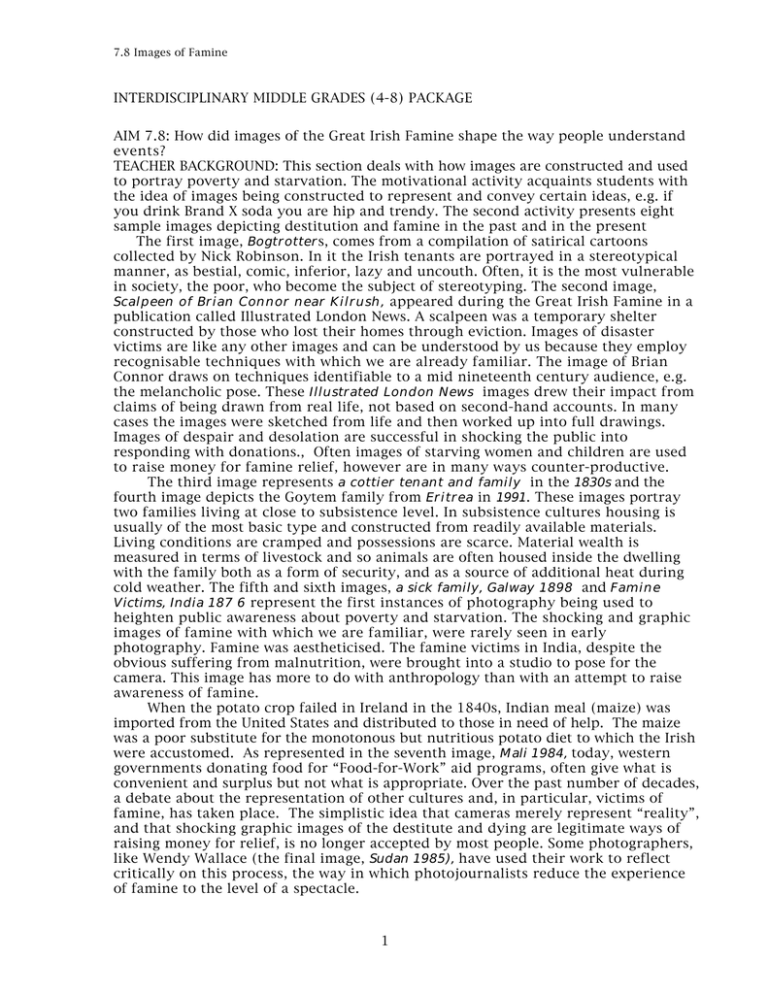
7.8 Images of Famine INTERDISCIPLINARY MIDDLE GRADES (4-8) PACKAGE AIM 7.8: How did images of the Great Irish Famine shape the way people understand events? TEACHER BACKGROUND: This section deals with how images are constructed and used to portray poverty and starvation. The motivational activity acquaints students with the idea of images being constructed to represent and convey certain ideas, e.g. if you drink Brand X soda you are hip and trendy. The second activity presents eight sample images depicting destitution and famine in the past and in the present The first image, Bogtrotters, comes from a compilation of satirical cartoons collected by Nick Robinson. In it the Irish tenants are portrayed in a stereotypical manner, as bestial, comic, inferior, lazy and uncouth. Often, it is the most vulnerable in society, the poor, who become the subject of stereotyping. The second image, Scalpeen of Brian Connor near Kilrush, appeared during the Great Irish Famine in a publication called Illustrated London News. A scalpeen was a temporary shelter constructed by those who lost their homes through eviction. Images of disaster victims are like any other images and can be understood by us because they employ recognisable techniques with which we are already familiar. The image of Brian Connor draws on techniques identifiable to a mid nineteenth century audience, e.g. the melancholic pose. These Illustrated London News images drew their impact from claims of being drawn from real life, not based on second-hand accounts. In many cases the images were sketched from life and then worked up into full drawings. Images of despair and desolation are successful in shocking the public into responding with donations., Often images of starving women and children are used to raise money for famine relief, however are in many ways counter-productive. The third image represents a cottier tenant and family in the 1830s and the fourth image depicts the Goytem family from Eritrea in 1991. These images portray two families living at close to subsistence level. In subsistence cultures housing is usually of the most basic type and constructed from readily available materials. Living conditions are cramped and possessions are scarce. Material wealth is measured in terms of livestock and so animals are often housed inside the dwelling with the family both as a form of security, and as a source of additional heat during cold weather. The fifth and sixth images, a sick family, Galway 1898 and Famine Victims, India 187 6 represent the first instances of photography being used to heighten public awareness about poverty and starvation. The shocking and graphic images of famine with which we are familiar, were rarely seen in early photography. Famine was aestheticised. The famine victims in India, despite the obvious suffering from malnutrition, were brought into a studio to pose for the camera. This image has more to do with anthropology than with an attempt to raise awareness of famine. When the potato crop failed in Ireland in the 1840s, Indian meal (maize) was imported from the United States and distributed to those in need of help. The maize was a poor substitute for the monotonous but nutritious potato diet to which the Irish were accustomed. As represented in the seventh image, Mali 1984, today, western governments donating food for “Food-for-Work” aid programs, often give what is convenient and surplus but not what is appropriate. Over the past number of decades, a debate about the representation of other cultures and, in particular, victims of famine, has taken place. The simplistic idea that cameras merely represent “reality”, and that shocking graphic images of the destitute and dying are legitimate ways of raising money for relief, is no longer accepted by most people. Some photographers, like Wendy Wallace (the final image, Sudan 1985), have used their work to reflect critically on this process, the way in which photojournalists reduce the experience of famine to the level of a spectacle. 1 7.8 Images of Famine REFLECTION: Teachers universally recommend that students brainstorm descriptions of pictures as a full class and that teachers write the lists on the board. This will help students see things they might otherwise have missed in the pictures. A drawing like the “Bogtrotters” has many images. Teachers may need to direct student attention to parts of the cartoon and to ask questions that encourage students to discuss their interpretations. Direct students to look at the faces. How do the cartoonists make people look? People are heavy, have many potatoes, yet are wearing rags. What is the cartoonist saying? People are smiling while running through a bog or mud. What image does the cartoon give of thiese people? Why? ASSESSMENT: - Students will demonstrate their understanding of multiple perspectives on historical events. - Students will demonstrate their ability to use local events to explain broader historical developments. - Students will demonstrate their ability to evaluate historical events based on the use of evidence. - Students will compare events in past and present and from different societies. DO NOW ACTIVITY: Students bring in advertisements from magazines which focus on the current “in” style for children their ages. A collection of these should be displayed on the blackboard MOTIVATIONAL ACTIVITY: The motivational activity acquaints students with the idea of images being constructed to represent and convey certain ideas, e.g. if you drink Brand X soda you are hip and trendy. ask students to describe the image they see. What message is the advertiser trying to convey? How and why does the advertising strategy work? Ask students to imagine they are aliens from outer space and the image before them is the only available one of what the earth is like. Ask the students to describe the earth, what life is like. Build up a web of keywords on the board. Discuss. TRANSITIONAL ACTIVITY: During the discussion it should become apparent that the media construct images in certain ways to sell certain products (e.g. beautiful people drink certain drinks). The aliens viewing earth through the picture are seeing only a small fragment of earth. There are many things left out. The image is selective. Our ideas and knowledge of other cultures rely on images which do not accurately portray those cultures. ACTIVITY: Through the use of famine imagery (both historical and contemporary) students call into question the way in which images are constructed, portrayed and to what ends are they used. This activity is intended to develop the students’ critical faculties. The notion of media-manipulation can be applied to any series of images. Put one of each image on display on the blackboard and number them 1-8. Divide the class into groups of four, giving each group a different image and its descriptiver paragraph. The students discuss the images and descriptive paragraphs prepare to present what they discovered to class. SUMMARY QUESTIONS: How do images shape the way people understand events like the Great Irish Famine? HOMEWORK: A study conducted in Ireland found that in the coverage of the Rwanda crisis in 1994 only 15% of the people quoted newspapers were Rwandan. Most information came from journalists, aid workers, development agencies and politicians commenting on the situation. How would you feel if 85% of the information in a newspaper article about your community was coming from people who did not live there? Why? APPLICATION: How are images from the past and present similar and different? How do you explain this? 2 7.8 Images of Famine Descriptive Captions for Each Image 1. Bogtrotters In the late 18th century there was a huge population increase in Ireland. More and more people were forced to move to marginal ground as the competition for land increased. Mountain fringes and bogland were brought into cultivation for the first time. The potato was the only crop that would grow in marginal ground but it needed a lot of fertiliser. By the late 1830s, it was believed that approximately 2 to 3 million Irish people were entirely dependent on the potato. As a result, a stereotype developed in England of the Irish poor as a lazy people, growing a lazy crop (potato), in lazy beds (hand cultivated ridges). They were called “Bogtrotters.” This image shows the tenants as if they were animal-like and uncivilised. 2. Scalpeen of Brian Connor near Kilrush, Co. Clare. Using the thatch and timbers of their destroyed home, the evicted family built a temporary shelter in a ditch or on waste ground, known as a scalpeen. If these were erected on the landlord’s property the evicted families were hunted out by bailiffs. Nearly 7,000 people were evicted in Kilrush between August 1848 and January 1849, when evictions were continuing at a rate of 150 persons per week. The main figure in this image is portrayed sadness and depression. 3. A Cottier Tenant and Family, 1830s This image was drawn by a landlord, James Connery, and depicts one of his cottier tenant’s cabins in County Waterford. This one-roomed cabin seems very basic. It has neither a door nor glass in the windows. The livestock nd the various pieces of furniture and utensils show the relative prosperity of the cottier class in the early part of the 19th century. The prosperity of this class came under increasing pressure in the decades leading up to the Famine. By the 1850s, the cottier had almost totally disappeared in the west of Ireland. 4. Eritrea (1991) Gebremariam Goytem and his family live in Meshas, a mountain village in drought stricken southern Eritrea. The ox is vital for ploughing the soil in the hope of rain. It must be protected from the chill night air. In a subsistence culture, as in pre-Famine Ireland, people are often entirely dependent on one crop. This means if the climate, economy, politics, environment and trade changes they risk losing their only food supply. The poor often farm land communally. They pool their limited resources, all they have. Livestock provide an important source of labour and as a result, often receive better care than the family members themselves. 3 7.8 Images of Famine 5. A sick family, Carraroe, County Galway (1898) Although photography existed in Ireland by 1850, no photograph of a victim of the Great Irish Famine is known. Until recently, photography was an expensive and time consuming hobby. It was not until the end of the 19th century that famine victims were photographed. However, even when the victims were photographed, the scene was almost always staged by the photographer. This photograph was taken as part of The Mansion House Committee’s Survey into the relief of distress in the west and south of Ireland (1898). The committee’s illustrated report looked at how the conditions of the poor could be improved. Photographs were taken to depict victims of famine, beggars, people afflicted by disease, diseased livestock, and participants on relief schemes. This collection was one of the first times photography was used to inform the public about the life of the poor. 6. Famine Victims, India (1876) by Captain William Willoughby Hooper This image was taken by an English army officer in India in 1876 when Britain ruled India. It is claimed the camera never lies but early photographic images such as this merely reinforced preconceived ideas of less-developed cultures. Images, without captions explaining any of the conditions which brought the image about, are open to endless interpretation. 7. Mali, (1984) In this image a girl from the Fulani tribe, Mali, west Africa, with a can of tinned chicken, the kind of food that is almost universally disliked by these recipients. Normally, their staple diet would be grain (e.g. millet), supplemented occasionally by a little meat and dried fish. For nomads like the Fulani, cattle are a “walking bank.” In times of severe drought, when the cattle die through lack of pasture and water, the people are left destitute. 8. Sudan, 1985 (Wendy Wallace) The Hadendowa people, nomads who live in eastern Sudan, were among the first to be affected by the mid-1980s famine. Many came out of their traditional habitat -- the hills -- and gathered by the main road between Khartoum and Port Sudan, looking for help. While trucks thundered by, loaded with cotton and dura grown for export (cash crops), the children and women starved (the men went to towns looking for work). When a British film crew visited this area, the Hadendowa brought out this child for “display,” knowing that emotive images of starving children can more easily bring the relief aid they needed. 4

